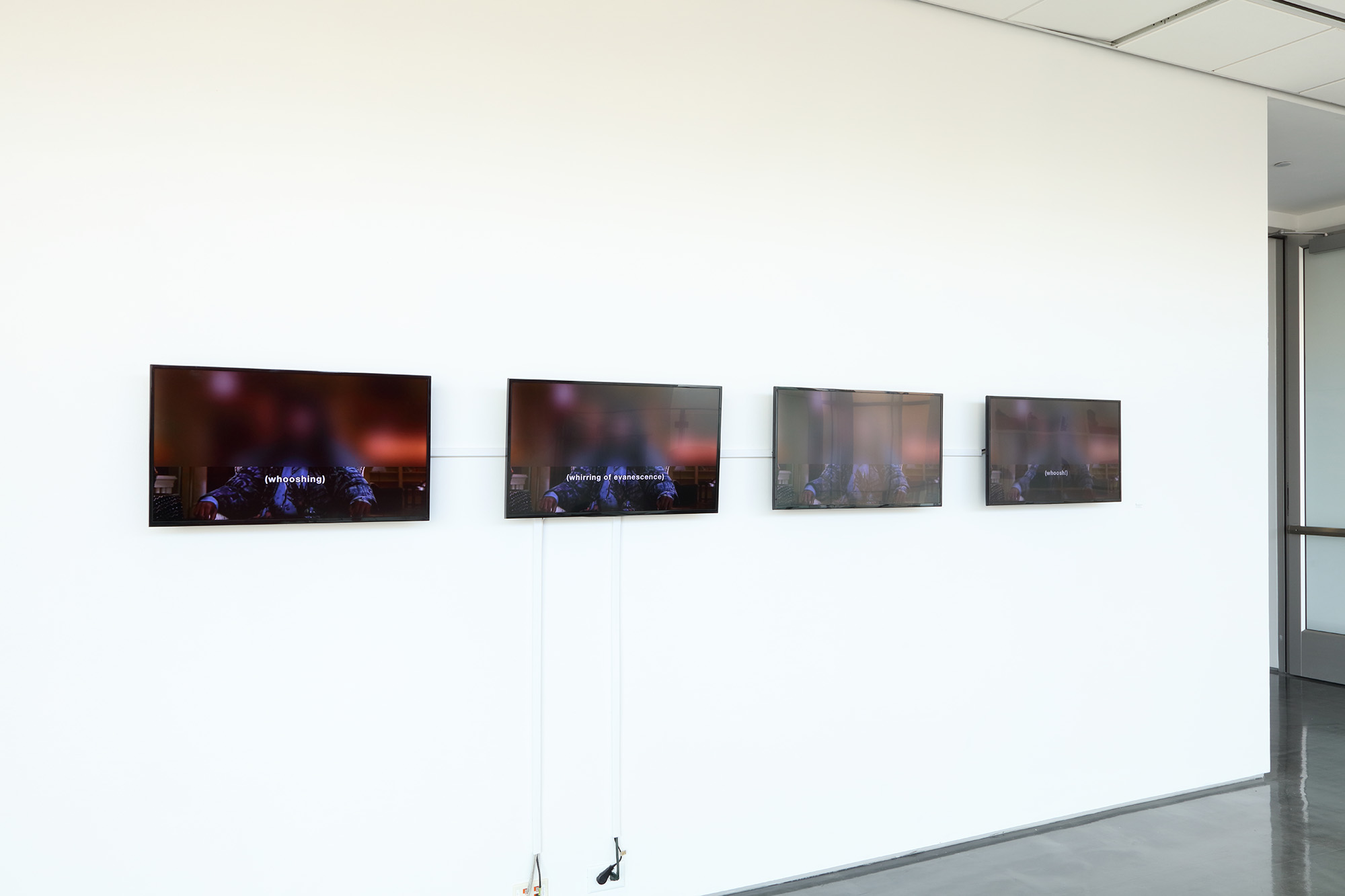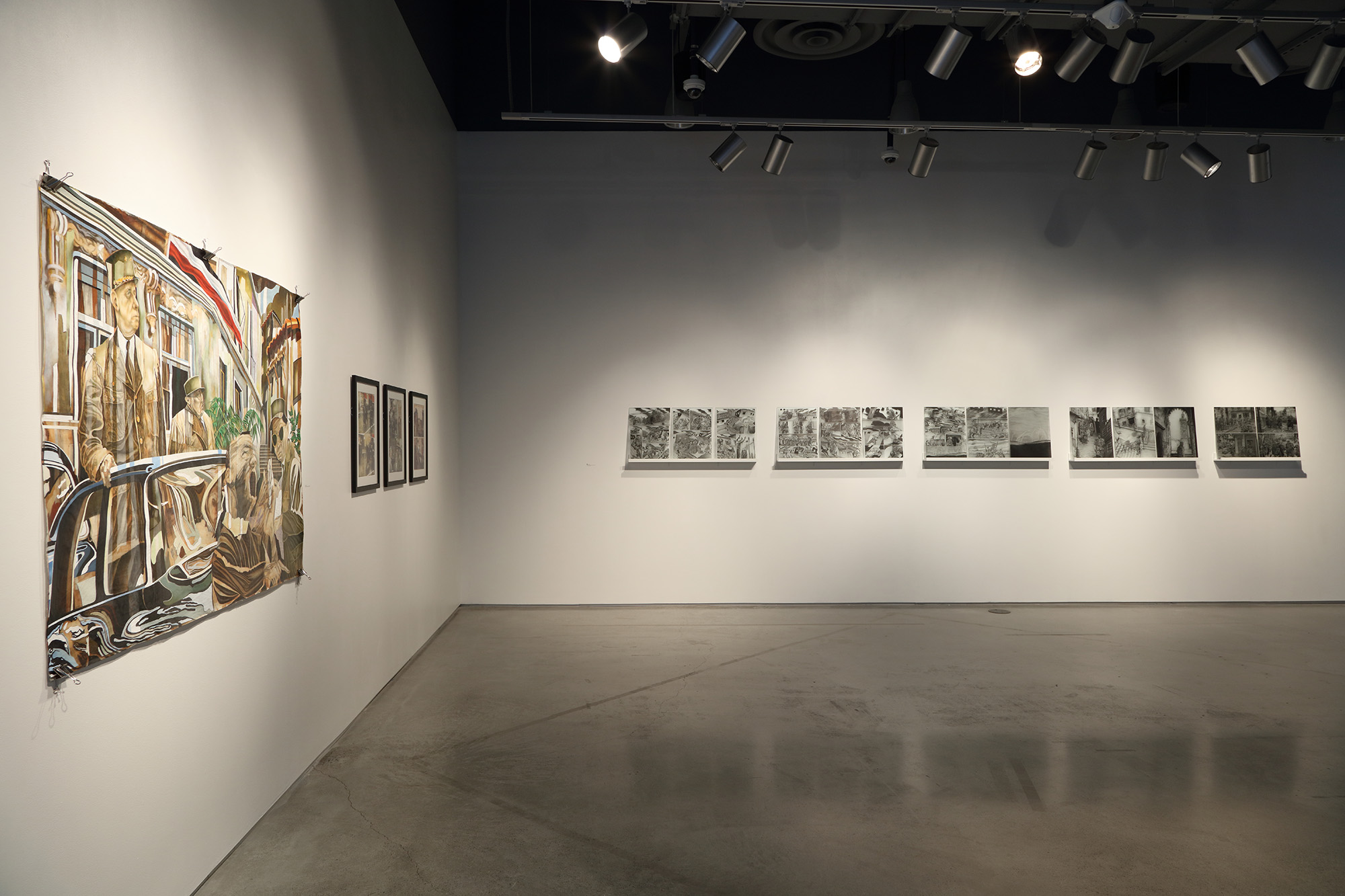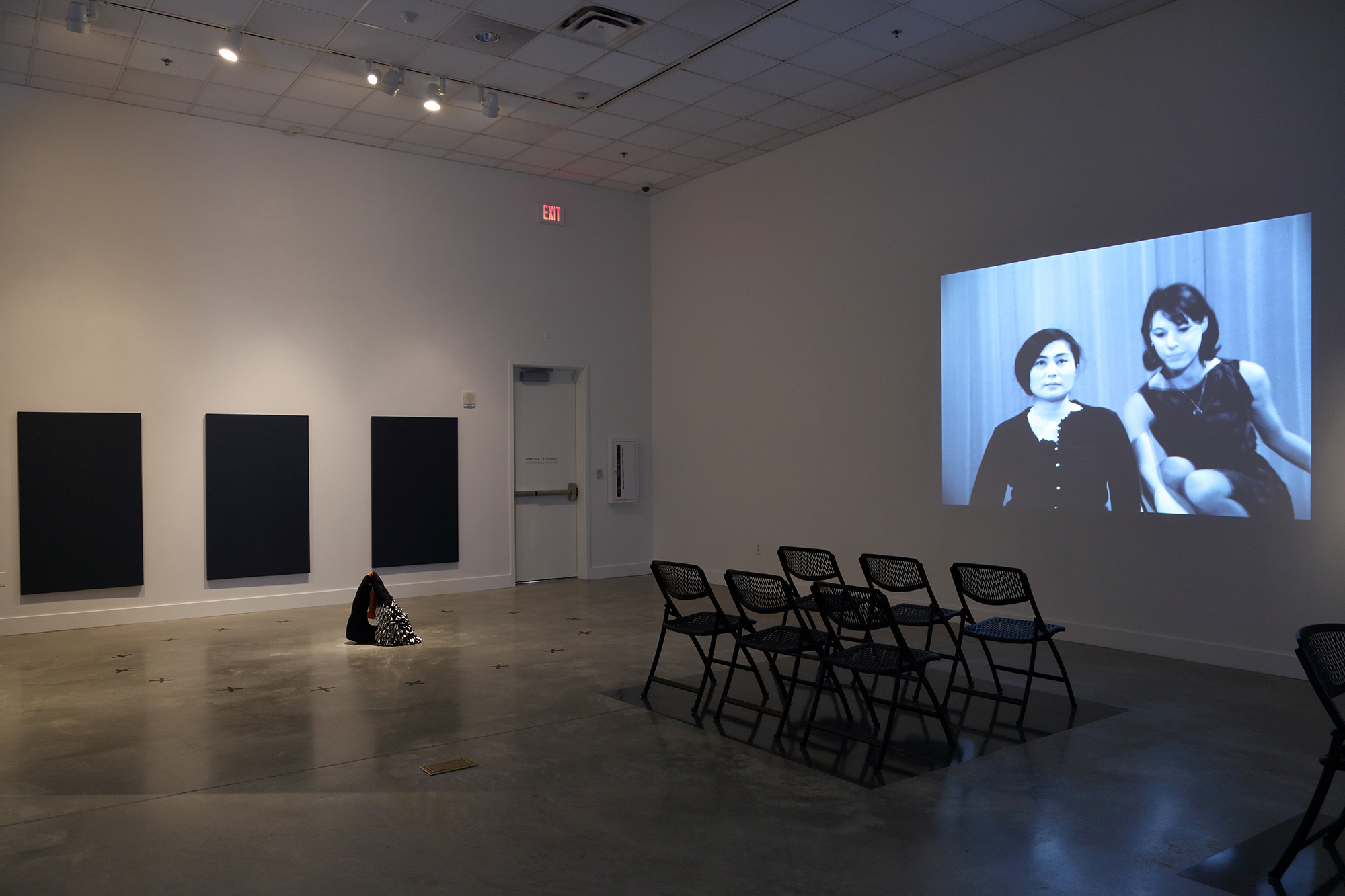Louder than Words, installation view, 2019 [photo: Mike Jensen; courtesy of Zuckerman Museum of Art, Kennesaw, GA]
Louder Than Words
Share:
“What are you?”
“To define is to limit.”
“Give me a clue.”
— Oscar Wilde, The Picture of Dorian Gray
A foremost flaw of words: in naming something, you point to a part of what it is but exclude or destroy a larger part of what it also is, or could be. We see and feel and experience. We wish to relay or recreate experience. We reach for a sequence of words to do so. Something is conveyed, but something is lost—the ineffable, the repressed, or the omitted. Artists who wish to represent sensations that standard linguistic rules cannot encompass often turn to indeterminacy. They take advantage of ambiguity or silence.
I rolled over him. We rolled over me. They rolled over him. We rolled over us.
— Vladimir Nabokov, Lolita
Writers have obscured the distinctions between subject and object, or narrator and character, as painters have visually conflated ground and foreground, sky and sea. They have given definition to their subjects, but vaguely enough that mystery, poetry, and interpretive room survive.
Christine Sun Kim, Close Readings, video installation, 2019 [photo: Mike Jensen; courtesy of Zuckerman Museum of Art, Kennesaw, GA]
The art on view at the Zuckerman Museum’s current exhibition, Louder than Words, takes as its starting point a radical recognition of words’ limitations. However, while the exhibition evinces dissatisfaction with words, it is rich in language. Not the most omnipresent form of language—verbal language—but the rhythmic-tonal language of music, the visual language of the body, the haptic language of touch. And it is not merely the criterion of “wordless language” that unites the artworks here. If that were so, just about any work of instrumental music or visual art could have been included. Rather, the works in Louder than Words share a common insistence upon deconstructing language, inventing new languages, or attuning us to latent meanings in extant language. The most striking and urgent pieces in Louder than Words are the products of people for whom conventional language (i.e., the dominant spoken language of their society) did or does not work, because of physical constraints (deafness, muteness), sociopolitical constraints (censorship, marginalization), or the intersection of the two.
Probably the first artwork museum-goers will see is Christine Sun Kim’s Close Readings (2005), a video installation hung on the outside wall of the first of two galleries. Words feature heavily but exceptionally here. Four muted TVs simultaneously show clips from a sequence of several different films. Although at any given moment the images displayed are the same, the subtitles are vastly different. Some of them, such as “the sound of someone alone,” are richly ambiguous. Others, such as “horse galloping” or “sound of waves” also leave plenty of interpretive space (At what volume? Or speed?), and are of dubious use to someone who never heard a horse gallop or waves lap against a beach. Kim, who was born deaf, thus makes strikingly salient the difficulties, absurdities, and possibilities that a deaf person might encounter when watching subtitled media. She also touches on a larger philosophical issue: we are incessantly translating or interpreting what we see or hear, choosing a single way of considering an object out of myriad options.
Geo Sipp, From series Wolves in the City, installation view, 2019 [photo: Mike Jensen; courtesy of Zuckerman Museum of Art, Kennesaw, GA]
Nearby, Geo Sipp’s illustrations of the Algerian War of Independence require that viewers, rather than read an array of texts attached to an image, imagine the words for themselves. The illustrations are for a graphic novel titled Wolves of the City that Sipp, director of the School of Art and Design at Kennesaw State University, has been researching and working on for almost 10 years. We witness French soldiers patrolling Algerian streets, bombing Algerian insurgents, arresting Algerian civilians. The absence of captioning thus allows the images to affect viewers without textual mediation. The wordlessness here may also reflect how the French colonial empire (and colonizers throughout history) attempted to render colonized subjects voiceless, so as to suppress dissent.
Self-imposed voicelessness plays a prominent role in Yoko Ono’s performance artwork Cut Piece (1964), which is projected on a gallery wall in the Zuckerman. Ono sits onstage in Carnegie Recital Hall, staring expressionlessly, silently ahead. A pair of scissors rests beside her. The audience members are told they can come on stage and cut her clothing. They are told they can, not that they should. Over the course of nine bleak minutes, audience members eagerly walk onstage and snip at bits of her clothes, until she is in rags, holding up her torn brassiere with mute dignity. The invasive liberties audience members take with Ono become symbolic of the exploitation done to those whose voices are silenced or ignored.
Louder than Words, installation view, 2019 [photo: Mike Jensen; courtesy of Zuckerman Museum of Art, Kennesaw, GA]
Not all the works in Louder than Words have obvious sociopolitical resonances. John Cage’s Water Walk (1960), in which a variety of household objects (radio, bathtub, pressure cooker) that can be “played” at specified times, attunes listeners to the ambient noise-cum-music that is ever around them. Like Cage’s 4’ 33” (of which a facsimile score is also on display), Water Walk destabilizes the grammar of western music based on 12-tone equal temperament by placing attention on unwieldy, inharmonic sounds. We thus see that the rules which lend coherence and legibility to our world may also restrict our sense of what is good, beautiful, or even existent. Dara Birnbaum’s videotaped performance Chaired Anxieties: Abandoned (1975), which consists of the artist striking a succession of poses on and around a chair, alerts us to the potential of body language to convey incredibly specific psychic states and attitudes. It is cast in a particularly revealing light by contemporary discourses that aim to emphasize the body’s communicative powers over those of the mind.
Teresa Bramlette Reeves, the curator of Louder than Words, has done viewers a tremendous service by keeping label copy off gallery walls. Such text instead exists in a thoughtfully designed brochure. Contextualizing information is separated from the art, allowing viewers to first experience the work on an immediate level, before measuring their unfiltered impressions against those of the curator or the artists themselves. As the New York School painter Fairfield Porter once said, “People do not ask what something means because they do not know, but out of fear of their unconscious knowledge.” The considerate curation of Louder than Words permits the 16 artworks on display to voice themselves with all their wordless might and allows viewers not only to examine the artworks before them, but also their intuitive, unconscious reactions.
Louder Than Words is on view at the Zuckerman Museum of Art from February 2 – May 5, 2019.


